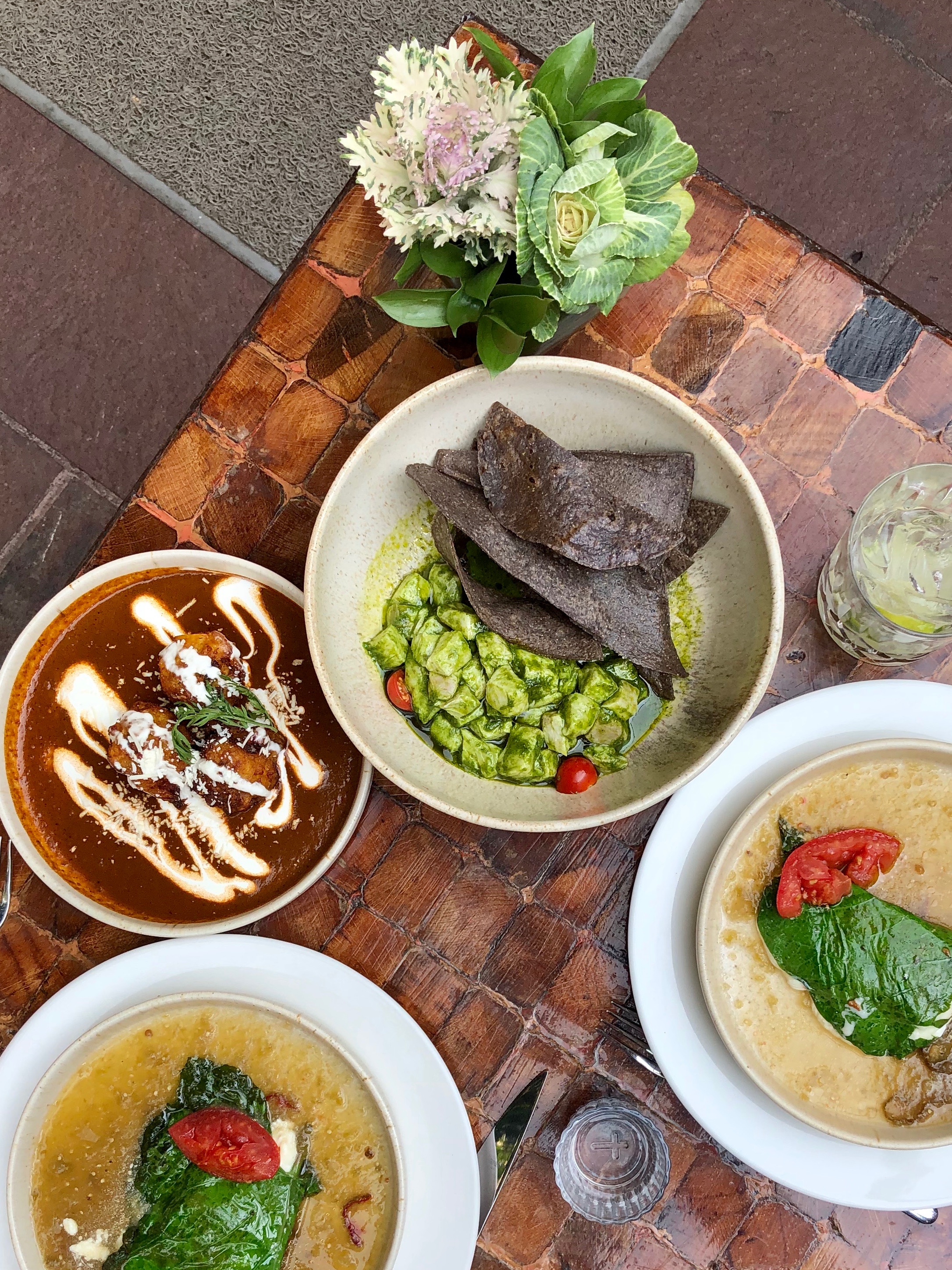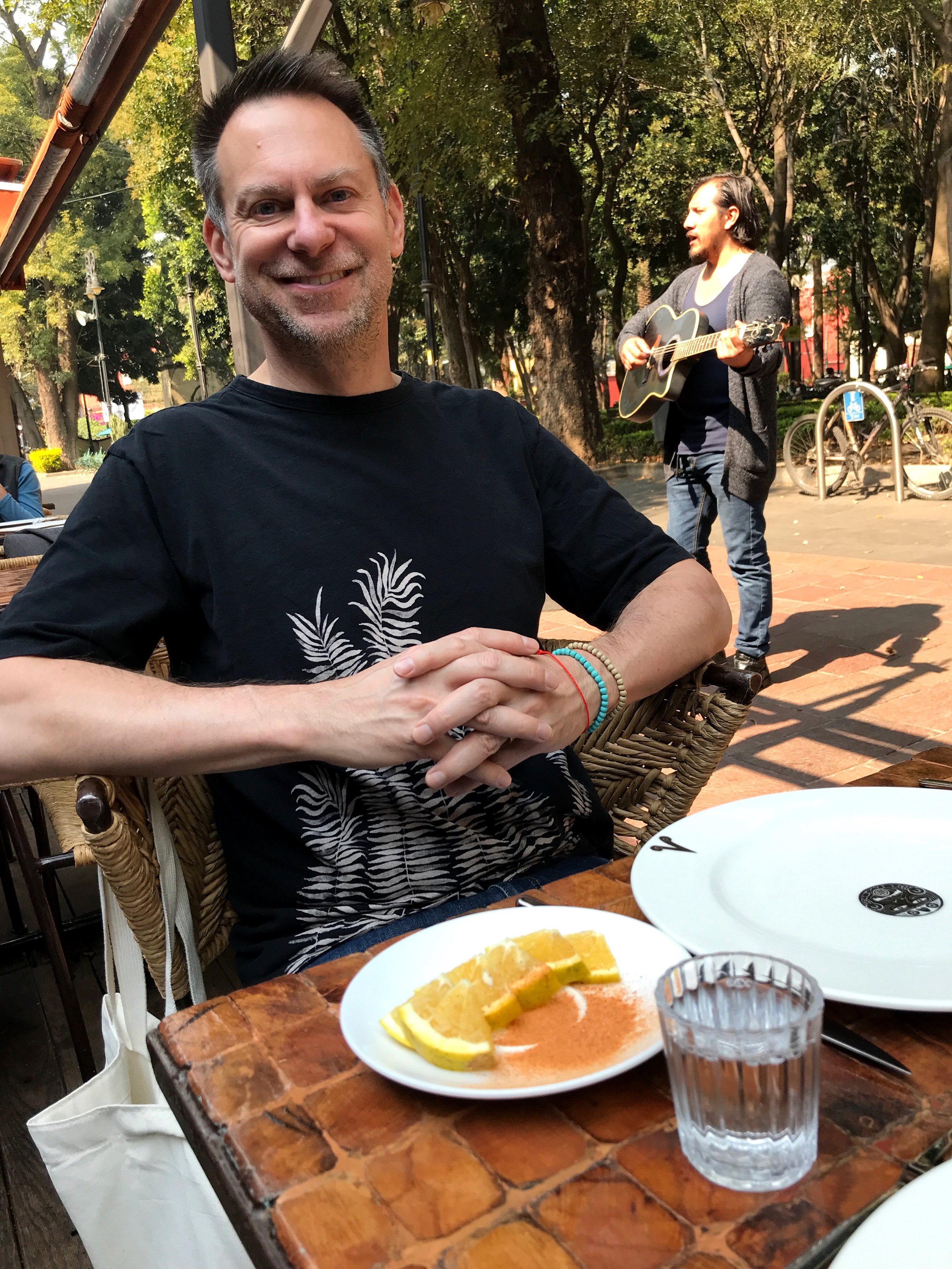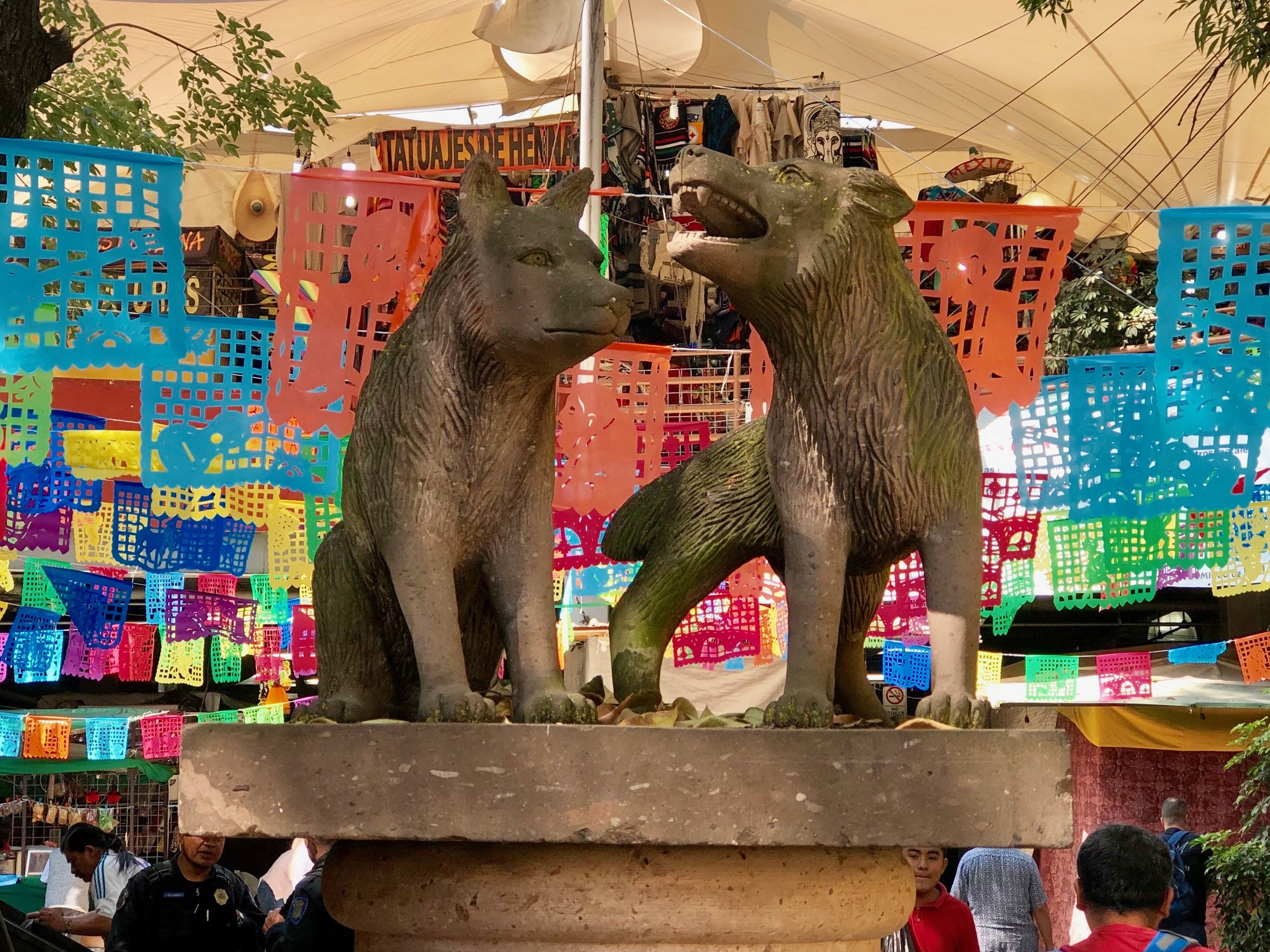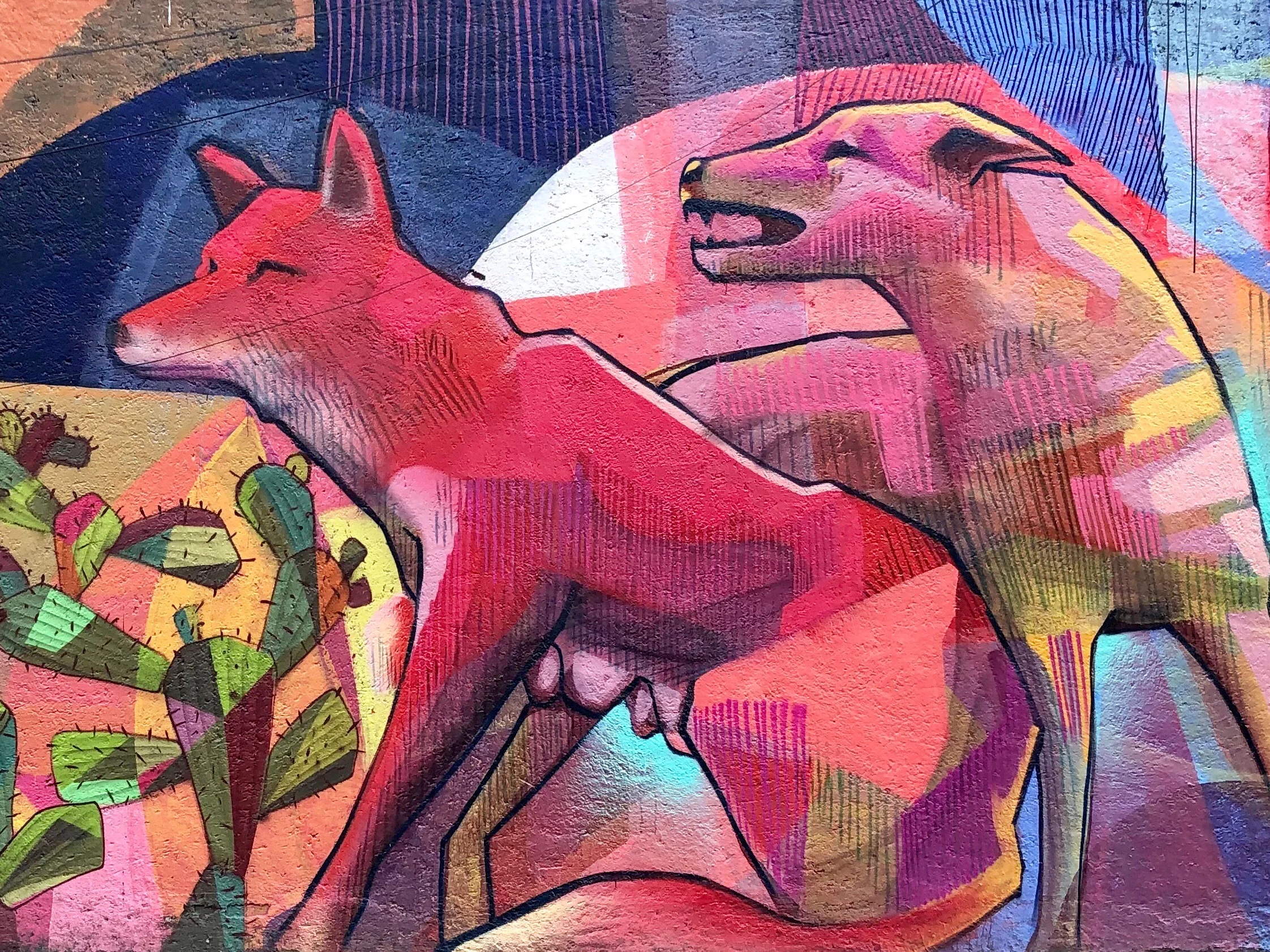Follow our six-stop walking tour of Mexico City’s bohemian neighborhood, including Plaza Hidalgo and Los Danzantes restaurant.
After visiting Frida’s house, explore the boho hood of Coyoacán and purchase some traditional regional handicrafts at the artisanal market.
There’s much to do in the charming neighborhood of Coyoacán beyond La Casa Azul, the lifelong home and studio of famed Mexican painter Frida Kahlo.
The municipality’s name comes from Coyohuacan, Nahuatl for “the Place of Coyotes.” This colonia, or neighborhood, features meandering streets filled with well-preserved colonial buildings, delicious restaurants and handicraft markets waiting to be explored.
You’ll see balloon vendors all over CDMX.
All you’ll need for a perfect afternoon in Coyoacán is a comfortable pair of shoes and a sense of adventure — the area is walkable, and all of the stops listed below can easily be explored by foot.
The Fuente de los Coyotes in Coyoacán
Make a Splash
Stop 1: Plaza Hidalgo
Your journey begins in the historic heart of Coyoacán, just a few blocks from La Casa Azul. On Avenida Francisco Sosa, you’ll find not one, but two public squares: Jardín Centenario, which memorializes the 100th anniversary of Mexico’s independence, and the Plaza Hidalgo. Together they form a typical colonial town square, complete with benches for people-watching, gazebos for music and vendors selling balloons.
Near the entrance of Plaza Hidalgo, a street artist was selling woven palm-leaf crickets. We purchased a pair for 50 pesos each (about $2.50), and as the vendor was handing them to us, a woman seated on a nearby bench offered her advice by telling us to use hairspray to keep them green.
People push crickets on you everywhere you go in Mexico City. These palm ones are more appetizing than the ones in the croquetas we ate.
Here you’ll find a circular stone fountain known as the Fuente de los Coyotes, or Fountain of the Coyotes, the animals from whom the borough takes its name. The iconic landmark occupies the center of the plaza and features two bronze coyotes by sculptor Gabriel Ponzanelli. Numerous spouts located around the perimeter spray graceful arcs of water into the air over the playful pair.
Be sure to stop into the exquisite Iglesia de Coyoacán, the large cathedral, across the way.
Ignacio Allende Esquina Avenida Miguel Hidalgo
Grab a bite on the patio of Los Danzantes, just off the park, for good food and people-watching.
Let’s Dance
Stop 2: Los Danzantes
On the periphery of the square is Los Danzantes, the Dancers, a multi-story restaurant in a colonial-era building with panoramic views of the park. Wally’s coworker Juls lived in Mexico City, and this is one of her favorite restaurants. We were seated outside on the patio terrace, and similar to the cafés of Paris, it was a great place to watch the world go by and enjoy a leisurely meal. While we were there, a guitarist paused for a moment as he passed by, looking to see if there might be an interested party willing to pay him to play a song or two. The restaurant also has its own mezcal distillery and grows seasonal produce in garden plots called chinampas in Xochimilco.
The bar at Los Danzantes
We had ceviche, cricket croquetas and hoja santa (holy leaf), a local specialty stuffed with goat cheese.
Mezcal and a mariachi are all it takes to make Duke happy.
Plaza Jardín Centenario 12
Look for these yellow arches across from the Jardín Centenario to enter the handicraft market.
Get Crafty
Stop 3: Mercado Artesanal Mexicano
After lunch, visit the Mexican Craft Market and walk beneath garlands of fluttering papel picado, colorful cut-tissue paper bunting. The two-story market has dozens of craft stalls featuring a wide variety of traditional Mexican handicrafts and regional specialties from all over the country, all in one place.
You’ll spot the coyotes for which the colonia is named all over the place.
Colorful skulls on offer at the craft market
We headed upstairs first, but it seemed to be endless stalls of tattoo artists and not many handicrafts. The first floor, though, was more our speed. Wally and are were especially drawn to the colorful Oaxacan alebrijes, traditional folk art depicting fantastical creatures embellished with brilliant patterns and colors. (We have a thing for the surreal.) Each small wooden totem is carved by hand, often using nothing more than a simple pocket knife. We brought home a strange little skeleton, a green and orange insect and a black cactus with a bright pink flower and hummingbird on top of it.
When I purchased an unusual-looking doll made from a bulbous gourd with coarsely braided rope pigtails, two tiny breasts and coconut shell limbs (200 pesos, or $10), Wally replied, “You like things that look old, are a little bit cuckoo and are unlike anything we’ve seen elsewhere.” He knows me so well.
Stalls often sell the same crafts at different prices, so shop around — but don’t expect to bargain for a lower price.
Felipe Carrillo Puerto 25
BONUS STOP!
Pop into la Iglesia de Coyoacán (aka Parroquia San Juan Bautista) across the square.
The façade looks plain, but the inside is awash in gilded niches, sweeping arches and hand-painted ceiling frescos, with a peaceful cloister around back.
If that hasn’t convinced you, you can hunt down the creepy life-size mannequins of Christ and a dead baby!
Grab a coffee and snack at Panadería Pública.
Take a Coffee Break
Stop 4: Panadería Pública
If shopping has worn you out, we recommend stopping for a delicious pastry paired with a great cup of coffee at the Panadería Pública for an afternoon pick-me-up. There’s an array of options here, including traditional conchas, campesinos and orejas, as well as French baguettes, croissants and pain au chocolat to name a few. I ordered a café con leche and Wally got his latte con leche light. We also purchased a pastelito de guayaba, a puff pastry similar in size and shape to a turnover, filled with cream cheese and guava paste. Stop to chat with the friendly staff.
Higuerra 22
La Concepción
The marigold yellow façade of La Conchita has seen better days but still has charm.
Goin’ to the Chapel
Stop 5: Plaza de la Conchita
A short stroll southeast is the leafy Plaza de la Conchita in the colonia La Concepción, a quiet sanctuary that feels worlds away from the crowds of tourists visiting La Casa Azul just a few miles away. The small square contains a pale yellow, timeworn and weather-beaten beauty of the 16th century, the Churrigueresque, or Spanish Baroque-style, chapel known as La Conchita. One of the oldest in Mexico, it’s said that the conquistador Hernán Cortés ordered the church to be built on top of a Toltec altar soon after he settled in Coyoacán. The village was used as the base for the conquistadors after they conquered the Aztec Empire.
The church is designed in the Churrigueresque, or Spanish Baroque, style.
Duke sits on the steps around back.
Unfortunately, the chapel was closed, so we couldn’t venture inside, but the building itself is a charming example of colonial architecture.
The fellas love to take jumping shots.
Golden hour made the church walls glow.
Fernández Leal
La Concepción
Teenagers practice salsa moves at the end of a striking, geometrical arbor.
Park It
Stop 6: Frida Kahlo Park
Just steps from the Plaza de la Conchita is Frida Kahlo Park. Here you’ll find a menagerie of topiary animals at the entrance and a fountain with a bronze sculpture of a nude woman with her legs drawn up, also by Ponzanelli. A group of teenagers was practicing salsa routines under an arbor of bougainvilleas.
Like the coyote fountain in Plaza Hidalgo, this woman was sculpted by Ponzanelli.
Wally loves Frida.
Is Diego jealous of Duke’s attention to Frida?
The park is a bit small in scale, but it’s worth stopping by to take a photo with the larger-than-life figures of Frida and Diego and to see the brightly colored mural by Dan Silva aka Polvoe, across the way on Tepalcatitla street.
The mascots of Coyoacán, as depicted by street artist Polvoe
A colorful mural across from Frida Kahlo Park caught our eye.
Fernández Leal and Avenida Pacifico
La Concepción
Coyoacán was easily one of our favorite places we visited in CDMX. You can see why this enchanting and storied part of the city has attracted artists and intellectuals over the years. –Duke












































